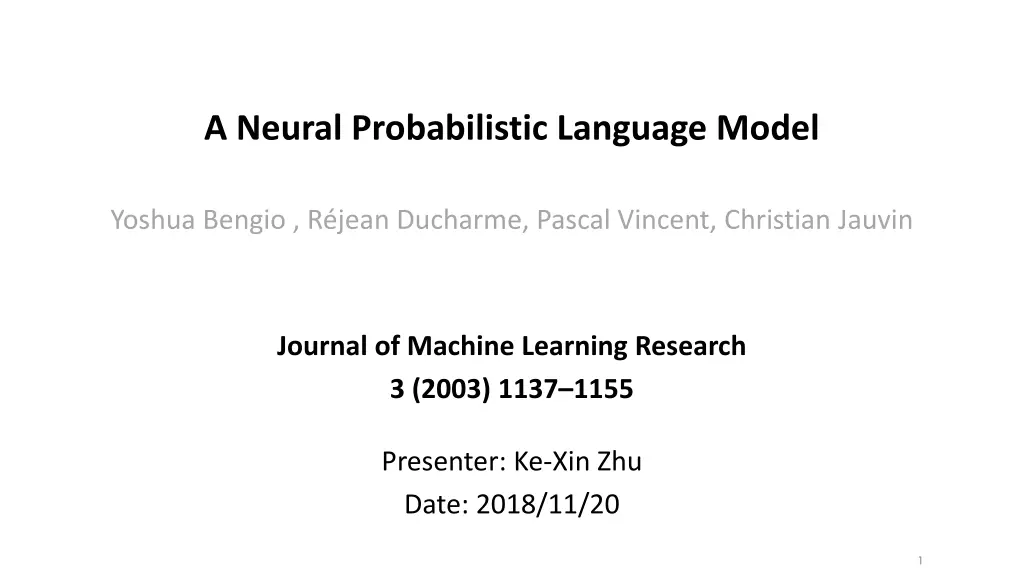
Neural Probabilistic Language Model by Yoshua Bengio
Dive into the realm of statistical language modeling with the groundbreaking Neural Probabilistic Language Model by Yoshua Bengio and team. Discover how this model tackles the curse of dimensionality and revolutionizes generalization through distributed word representations. Explore the essence of learning probability functions for word sequences and the impact on language model advancement.
Download Presentation

Please find below an Image/Link to download the presentation.
The content on the website is provided AS IS for your information and personal use only. It may not be sold, licensed, or shared on other websites without obtaining consent from the author. If you encounter any issues during the download, it is possible that the publisher has removed the file from their server.
You are allowed to download the files provided on this website for personal or commercial use, subject to the condition that they are used lawfully. All files are the property of their respective owners.
The content on the website is provided AS IS for your information and personal use only. It may not be sold, licensed, or shared on other websites without obtaining consent from the author.
E N D
Presentation Transcript
A Neural Probabilistic Language Model Yoshua Bengio , R jean Ducharme, Pascal Vincent, Christian Jauvin Journal of Machine Learning Research 3 (2003) 1137 1155 Presenter: Ke-Xin Zhu Date: 2018/11/20 1
Abstract (1/2) A goal of statistical language modeling is to learn the joint probability function of sequences of words in a language. This is intrinsically difficult because of the curse of dimensionality: a word sequence on which the model will be tested is likely to be different from all the word sequences seen during training. Traditional but very successful approaches based on n-grams obtain generalization by concatenating very short overlapping sequences seen in the training set. We propose to fight the curse of dimensionality by learning a distributed representation for words which allows each training sentence to inform the model about an exponential number of semantically neighboring sentences. The model learns simultaneously (1) a distributed representation for each word along with (2) the probability function for word sequences, expressed in terms of these representations. 2
Abstract (2/2) Generalization is obtained because a sequence of words that has never been seen before gets high probability if it is made of words that are similar (in the sense of having a nearby representation) to words forming an already seen sentence. Training such large models (with millions of parameters) within a reasonable time is itself a significant challenge. We report on experiments using neural networks for the probability function, showing on two text corpora that the proposed approach significantly improves on state-of-the-art n-gram models, and that the proposed approach allows to take advantage of longer contexts. 3
Statistical model of language A statistical model of language can be represented by the conditional probability of the next word given all the previous ones, since: 4
n-gram models The n-gram models construct tables of conditional probabilities for the next word, for each one of a large number of contexts, i.e.combinations of the last n 1 words: 5
Fighting the Curse of Dimensionality with Distributed Representations 1. 2. 3. 6
using neural networks to model high- dimensional discrete distributions 1. 2. 3. 4. - 7
Parallel Implementation 1. Data-Parallel Processing each processor works on a different subset of the data. 2. Parameter-Parallel Processing: parallelize across the parameters, in particular the parameters of the output units 10
Results(1/2) 13
Results(2/2) 14
